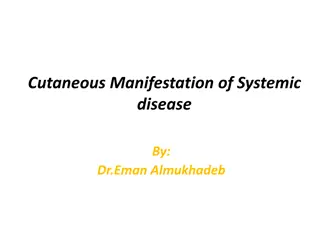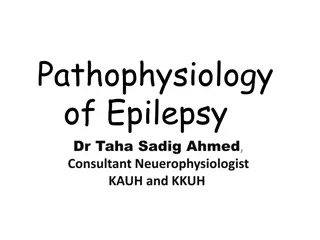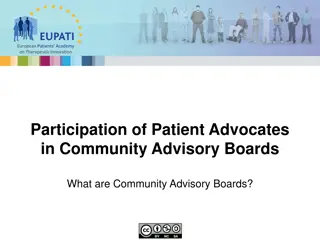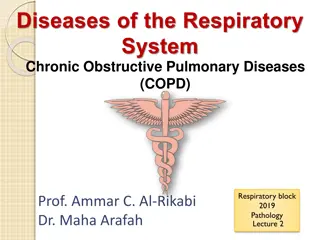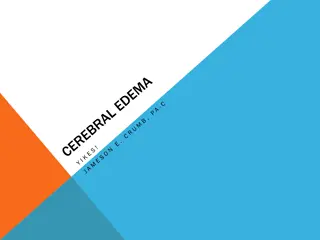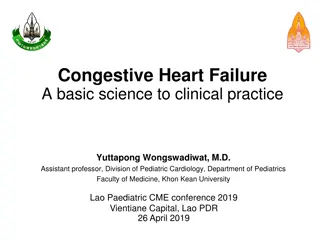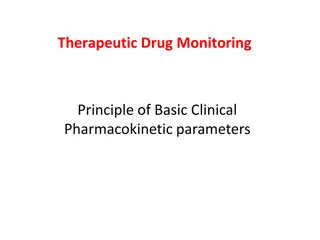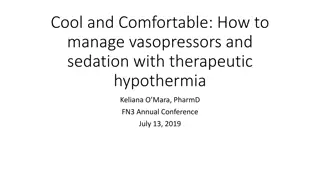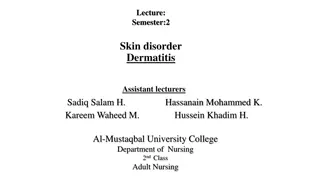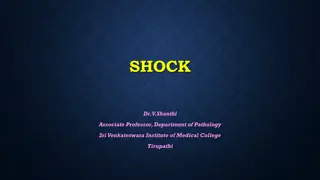Understanding Achalasia: Therapeutic Approaches, Pathophysiology, and Clinical Manifestations
Achalasia is characterized by a failure of the lower esophageal sphincter to relax, leading to difficulty in swallowing and regurgitation. The exact cause is unknown, but autoimmune factors and chronic infections may play a role. Symptoms include dysphagia, chest pain, regurgitation, and weight loss, with an increased risk of esophageal cancer. Diagnosis involves radiographic, manometric, and endoscopic evaluation. Treatment options include medication, pneumatic dilation, botulinum toxin injection, and surgery. Early detection and management are crucial in improving the quality of life for individuals with achalasia.
Download Presentation

Please find below an Image/Link to download the presentation.
The content on the website is provided AS IS for your information and personal use only. It may not be sold, licensed, or shared on other websites without obtaining consent from the author. Download presentation by click this link. If you encounter any issues during the download, it is possible that the publisher has removed the file from their server.
E N D
Presentation Transcript
ACHALASIA THERAPEUTIC APPROACHES
Achalasia ("does not relax") - loss of peristalsis in the distal esophagus and a failure of LES relaxation.
PATHOPHYSIOLOGY PATHOPHYSIOLOGY
ETIOLOGY The etiology of achalasia is not known Autoimmune disorder - associated with HLA-DQw1 - antibodies to enteric neurons Chronic infections with herpes zoster or measles viruses
Chagas disease (Trypanosoma cruzi) can result in a loss of intramural ganglion cells leading to aperistalsis and incomplete LES relaxation
CLINICAL MANIFESTATIONS Dysphagia Pts may adopt specific maneuvers to aid esophageal emptying: 1) Standing after eating to enlist aid of gravity 2) Raising arms after eating to increase the intrathoracic pressure 3) Use of large amount of water to wash food down Recurrent aspiration may result from chronic GER and may lead to pulmonary complications. Heartburn more so than GER is complained about, this occurs because of fermentation of retained food in the dilated esophagus Usually diagnosed between the ages of 25 and 60 years.
Other symptoms: Chest pain. Regurgitation. Dyspepsia . Weight loss. Aspiration. It associated with Increased risk for developing esophageal cancer (squamous cell type)
DIAGNOSIS radiographic, manometric, and endoscopic evaluation to confirm the diagnosis.
BARIUM SWALLOW Bird s Beak
A barium swallow - diagnostic accuracy is approximately 95% Absence of peristalsis In some patients, spastic contractions in the esophageal body ("vigorous" achalasia)
Manometry Elevated resting LES pressure Incomplete LES relaxation Peristalsis or simultaneous contractions
Endoscopy Exclude malignancies Dilated esophagus, residual material. Inflammation and ulceration Stasis - candida infection. The LES does not open spontaneously, traversed easily with gentle pressure
Features that suggest malignancy in achalasia 1)short duration of dysphagia. 2)significant weight loss. 3)age older than 60 years
THERAPEUTIC APPROACHES Four modalities: Pharmacotherapy Botulinum toxin Pneumatic dilation Surgical
Pharmacotherapy agents that relax SM and theoretically decrease LES pressure. Nitrates & calcium channel blockers (CCB) Side effects such as headaches and peripheral edema are common.
BALLOON DILATATION Weaken the LES by tearing its muscle fibers.
BOTULINUM TOXIN BTX reduce the LES pressure by selectively blocking the release of acetylcholine from presynaptic cholinergic nerve terminals in the myenteric plexus
LES is weakened by cutting its muscle fibers down to mucosa First described by Ernest Heller in 1914. Originally was of two myotomies: anterior and posterior. Modified Heller myotomy anterior myotomy ( Dor ). Excellent results have been reported in up to 95% of patients in select series. Traditionally accomplished by a transthoracic or transabdominal approach.
NEOPLASMS OF THE OESOPHAGUS Benign tumours Benign tumours of the oesophagus are relatively rare. True papillomas, adenomas and hyperplastic polyps do occur, but the majority of benign tumours are not epithelial in origin and arise from other layers of the oesophageal wall (gastrointestinal stromal tumour (GIST), lipoma, granular cell tumour). Most benign oesophageal tumours are small and asymptomatic, and even a large benign tumour may cause only mild symptoms
Malignant esophageal Tumors The vast majority of esophageal cancers are epithelial and fall into one of two types: 1- adenocarcinoma 2- squamous cell carcinoma. Squamous cell carcinoma generally affects the upper two-thirds of the oesophagus and adenocarcinoma the lower one-third. Worldwide, squamous cell cancer is most common, but adenocarcinoma predominates in the West and is increasing in incidence.
Adenocarcinoma Most esophageal adenocarcinomas arise from Barrett esophagus. increased rates of esophageal adenocarcinoma risk factors: - gastroesophageal reflux/Barrett esophagus - tobacco use - Exposure to radiation risk is reduced by: - diets rich in fresh fruits and vegetables. - Some serotypes of Helicobacter pylori
occurs most frequently in Caucasians and shows a strong gender bias, being sevenfold more common in men. Pathogenesis: Molecular studies suggest that the progression of Barrett esophagus to adenocarcinoma occurs over an extended period through the stepwise acquisition of genetic and epigenetic changes.
Clinical Features: pain or difficulty in swallowing, progressive weight loss, hematemesis, chest pain, or vomiting. occasionally discovered in evaluation of GERD or surveillance of Barrett esophagus. As a result of the advanced stage at diagnosis, overall 5-year survival is less than 25%.
Squamous Cell Carcinoma alcohol and tobacco use (polycyclic hydrocarbons, nitrosamines) Poverty caustic esophageal injury Achalasia Plummer-Vinson syndrome diets that are deficient in fruits or vegetables frequent consumption of very hot beverages Previous radiation to the mediastinum Human papilloma virus infection has also been implicated in esophageal squamous cell carcinoma in high-risk areas Fungus contaminated foods. occurs in adults older than age 45 and affects males four times more frequently than females. Risk factors include:
Clinical Features: - The onset of esophageal squamous cell carcinoma is insidious and it most commonly presents with dysphagia, odynophagia (pain on swallowing), or obstruction. - weight loss - Hemorrhage and sepsis may accompany tumor ulceration, - Occasionally, the first symptoms are caused by aspiration of food via a tracheoesophageal fistula. - The overall 5-year survival rate in the United States remains less than 20%, and varies by tumor stage and patient age, race, and gender.
spread Tumours can spread in three ways: invasion directly through the oesophageal wall, via lymphatics or in the bloodstream. Direct spread occurs both laterally, through the component layers of the oesophageal wall, and longitudinally within the oesophageal wall. Longitudinal spread is mainly via the submucosal lymphatic channels of the oesophagus. The pattern of lymphatic drainage is therefore not segmental, as in other parts of the gastrointestinal tract. Consequently, the length of oesophagus involved by tumour is frequently much longer than the macroscopic length of the malignancy at the epithelial surface. Lymph node spread occurs commonly.
Clinical features Early: non-specific dyspeptic symptoms or a vague feeling of something that is not quite right during swallowing. Some are diagnosed during endoscopic surveillance of patients with Barrett s oesophagus. dysphagia, but sometimes also regurgitation, vomiting, odynophagia and weight loss.
Late : recurrent laryngeal nerve palsy, Horners syndrome, chronic spinal pain and diaphragmatic paralysis. Other factors making surgical cure unlikely include weight loss of more than 20 per cent and loss of appetite. Cutaneous tumour metastases or enlarged supraclavicular lymph nodes may be seen on clinical examination and indicate disseminated disease. Hoarseness due to recurrent laryngeal nerve palsy is a sign of advanced and incurable disease. Palpable lymphadenopathy in the neck is likewise a sign of advanced disease.
Malignancy - most common cause of pseudoachalasia Invasion of the esophageal neural plexuses directly, or part of a paraneoplastic syndrome. Other tumors -esophagus, lung, lymphoma and pancreatic carcinoma Long term use of gastric band can lead to esophageal dilatation and pseudo achalasia
Investigation Endoscopy is the first-line investigation for most patients. It provides an unrivalled direct view of the oesophageal mucosa and any lesion allowing its site and size to be documented. Cytology and/or histology specimens taken via the endoscope are crucial for accurate diagnosis. The chief limitation of conventional endoscopy is that only the mucosal surface can be studied and biopsied. Other investigations are therefore usually required to define the extent of local or distant spread
General assessment and staging . Once the initial diagnosis of a malignant oesophageal neoplasm has been made, patients should be assessed first in terms of their general health and fitness for potential therapies. Transcutaneous ultrasound It is difficult to visualise mediastinal structures with transcutaneous ultrasound. With the relatively low-frequency sound waves
Bronchoscopy Many middle- and upper-third oesophageal carcinomas (and therefore usually squamous carcinomas) are sufficiently advanced at the time of diagnosis that the trachea or bronchi are already involved (Figure 62.46). Bronchoscopy may reveal either impingement or invasion of the main airways in over 30 per cent of new patients with cancers in the upper third of the oesophagus. Laparoscopy This is a useful technique for the diagnosis of intra-abdominal and hepatic metastases. It has the advantage of enabling tissue samples or peritoneal cytology to be obtained and is the onlymodality reliably able to detect peritoneal tumour seedlings
Computed tomography Computed tomography scanning is the modality most used to identify haematogenous metastases . Distant organs are easily seen and metastases within them visualised with high accuracy. Magnetic resonance imaging: adds no benefit to C.T scan. Endoscopic ultrasound: can determine the depth of spread of a malignant tumour through the oesophageal wall , the invasion of adjacent organs (T4) and metastasis to lymph nodes can also detect contiguous spread downward into the cardia and more distant metastases to the left lobe of the liver.
Positron emission tomography/computed tomography scanning Positron emission tomography (PET) in the context of cancer staging relies on the generally high metabolic activity (particularly in the glycolytic pathway) of tumours compared with normal tissues. The patient is given a small dose of the radio pharmaceutical agent 18F- fluorodeoxyglucose (FDG).
Principles At the time of diagnosis, around two-thirds of all patients with oesophageal cancer will already have incurable disease. The aim of palliative treatment is to overcome debilitating or distressing symptoms while maintaining the best quality of life possible for the patient. Some patients do not require specific therapeutic interventions, but do need supportive care and appropriate liaison with community nursing and hospice care services.
As dysphagia is the predominant symptom in advanced oesophageal cancer, the principal aim of palliation is to restore adequate swallowing. A variety of methods are available and ,given the short life expectancy of most patients.
Curative surgery The principle of oesophagectomy is to deal adequately with the local tumour in order to minimize the risk of local recurrence and achieve an adequate lymphadenectomy to reduce the risk of staging error. When such a margin cannot be achieved proximally, particularly with squamous cell carcinoma, there is evidence that postoperative radiotherapy can minimize local recurrence
Adenocarcinoma commonly involves the gastric cardia and may therefore extend into the fundus or down the lesser curve. Some degree of gastric excision is essential in order to achieve adequate local clearance and accomplish an appropriate lymphadenectomy. Excision of contiguous structures, such as crura, diaphragm and mediastinal pleura, needs to be considered as a method of creating negative resection margins.
Recent advances Endoscopic mucosal resection for these apparently early lesions has become increasingly popular, providing either a cure or at least sufficient histological information upon which to base a further management strategy. Photodynamic therapy (PDT) is an alternative approach that has largely been used in patients who were either unfit or unwilling to undergo surgery. This endoscopic technique relies on the administration of a photosensitiser that is taken up preferentially by dysplastic and malignant cells followed by exposure of an appropriate segment of the esophagus to laser light. The main drawback is skin photosensitization, so patients must avoid sunlight exposure in the short term.
summary Radical oesophagectomy is the most important aspect of curative treatment Neoadjuvant treatments before surgery may improve survival in a proportion of patients Chemoradiotherapy alone may cure selected patients, particularly those with squamous cell cancers Useful palliation may be achieved by chemo/radiotherapy or endoscopic treatments
Esophagectomy 3)Transhiatal oesophagectomy (without thoracotomy)
Esophageal Obstruction Structural (mechanical) obstruction Functional obstruction (disruption of the coordinated waves of peristaltic contractions) --------- Esophageal dysmotility
Esophageal dysmotility: - Nutcracker esophagus: - Diffuse esophageal spasm: - Lower esophageal sphincter dysfunction/hypertensive lower esophageal sphincter
Nutcracker esophagus: - High-amplitude contractions of the distal esophagus--- - contractions proceed in a coordinated manner - dysphagia, chest pain


